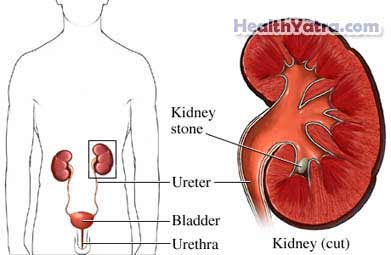परिभाषा
A nephrostomy is a procedure in which a tube called a catheter is placed into the kidney. The catheter is guided into the kidney by a computed tomography (CT) scanor ultrasound.
प्रक्रिया के कारण
A nephrostomy is done to drain urine from your kidney. This needs to be done when urine cannot come out as it normally does. Specific conditions that may cause this include:
- Damage to the bladder
- Blockage in the ureter, which is the tube that carries urine from the kidney to the bladder, due to:
- संक्रमण
- फोडा
- Kidney stone
- घाव का निशान
- A condition that is present at birth

A nephroscopy through a nephrostomy may also be used to look at the kidneys and ureters before other procedures are done, such as kidney stone removal. This may also help your doctor make a diagnosis.
संभावित जटिलताएँ
Complications are rare. But, no procedure is free of risk. If you are planning to have a nephrostomy, your doctor will review a list of possible complications, which may include:
- खून बह रहा है
- संक्रमण
- Damage to nearby organs and tissue
- Kidney function loss
- रक्त के थक्के
- Reaction to the anesthesia such as lightheadedness, low blood pressure, and wheezing
- दर्द
जटिलताओं के जोखिम को बढ़ाने वाले कारकों में शामिल हैं:
- धूम्रपान
- यकृत का काम करना बंद कर देना
- गर्भावस्था
- ब्लड थिनर का उपयोग
- लंबी बीमारी
क्या उम्मीद करें
प्रक्रिया से पहले
- At the appointment before the test:
- Your doctor may do tests like a CT scan or ultrasound. You may also have blood and urine tests.
- Questions your doctor may ask include: Are you pregnant? Do you have any allergies to contrast dye?
- Questions you should ask your doctor include: How long will the catheter need to stay in place? What signs should I look for in case there is a problem with the catheter?
- अस्पताल से घर जाने के लिए सवारी की व्यवस्था करें।
- Do not eat or drink for eight hours before your procedure. If you are taking medicines, ask your doctor if you should take them the morning of your procedure with a sip of water.
- अपनी दवाओं के बारे में अपने डॉक्टर से बात करें। आपको प्रक्रिया से एक सप्ताह पहले तक कुछ दवाएं लेना बंद करने के लिए कहा जा सकता है जैसे:
- विरोधी भड़काऊ दवाएं
- रक्त को पतला करने वाला
बेहोशी
You will receive a local anesthetic to numb the skin on your lower back. An IV will be placed. You will receive a sedative, pain medicine, and antibiotics through this IV.
प्रक्रिया का विवरण
A nephrostomy is usually done in an outpatient setting. You will not need to stay in the hospital overnight. Ultrasound or x-ray images will be used to locate your kidney and guide the doctor. A needle will be inserted through your skin and into your kidney. A contrast material will be injected through the needle to better view the kidney on the x-ray. The catheter will then be placed into your kidney. The catheter will come out of your skin and be attached to a collection bag. A dressing will be placed at the insertion site. Urine will drain from your kidney into the collection bag.
प्रक्रिया के तुरंत बाद
After the procedure, you will be monitored for 8-12 hours to make sure the catheter is draining urine. The urine may appear bloody at first. But, it will clear over time.
इसमें कितना समय लगेगा?
15-30 मिनट
यह कितनी चोट पहुंचाएगा?
You may feel soreness at the insertion site for several days after your nephrostomy. Your doctor will give you medicine to help with the pain.
प्रक्रिया के बाद की देखभाल
केयर सेंटर में
After the procedure, the staff may give you the following care to make you more comfortable and to help you recover:
- Your collection bag will be checked to make sure the catheter is draining your kidney well.
- You will be shown how to care for your catheter. You will be sent home with extra collection bags and dressing supplies.
You will be able to leave when your catheter is working and you are comfortable caring for it.
घर पर
जब आप घर लौटते हैं, तो आराम से रिकवरी सुनिश्चित करने के लिए निम्न कार्य करें:
- Ask someone to stay with you for the first 24 hours after the procedure.
- अपने डॉक्टर से पूछें कि कब नहाना, नहाना या पानी में भिगोना सुरक्षित है।
- Keep the insertion site and dressing dry. Protect it from getting wet when showering. You can use plastic wrap to cover it.
- Do not let the collection bag get too full before emptying it.
- Change your dressing every 2-3 days. If your dressing gets wet, loose, or dirty, change it. Always wash your hands before changing your dressing.
- अपने डॉक्टर के निर्देशों का पालन करना सुनिश्चित करें।
अपने डॉक्टर को बुलाओ
घर पहुंचने के बाद, निम्न में से कोई भी होने पर अपने डॉक्टर से संपर्क करें:
- Catheter problems:
- Urine no longer drains
- Catheter is bent or twisted
- Leakage occurs around the catheter
- बुखार या ठंड लगना सहित संक्रमण के लक्षण
- Urine becomes cloudy, bloody, or smells bad
- Sudden pain
- Redness, swelling, increasing pain, a lot of bleeding, or any discharge from the incision site
- दर्द जिसे आप दी गई दवाइयों से नियंत्रित नहीं कर सकते
आपातकालीन स्थिति में तुरंत चिकित्सा सहायता के लिए कॉल करें।
